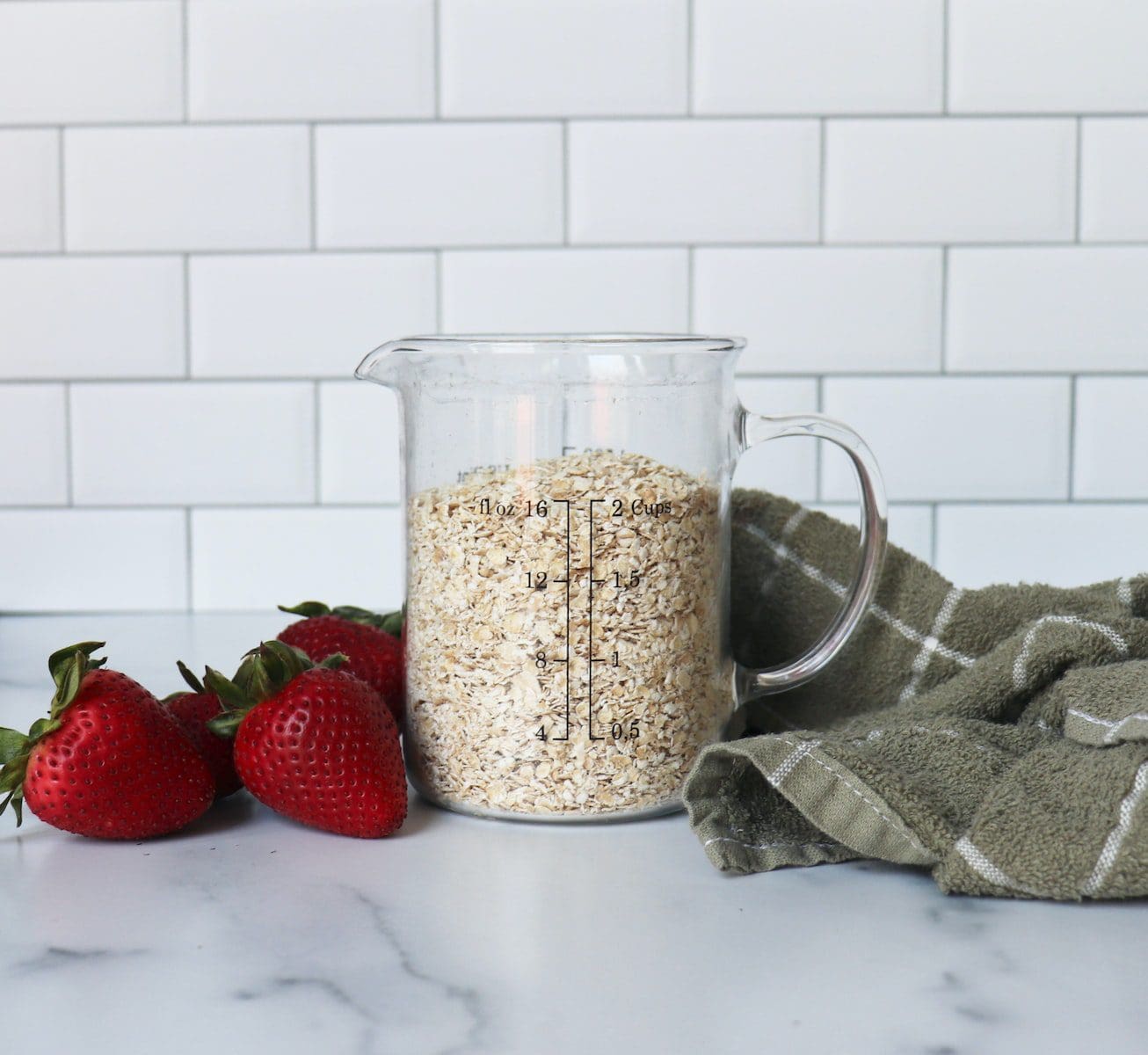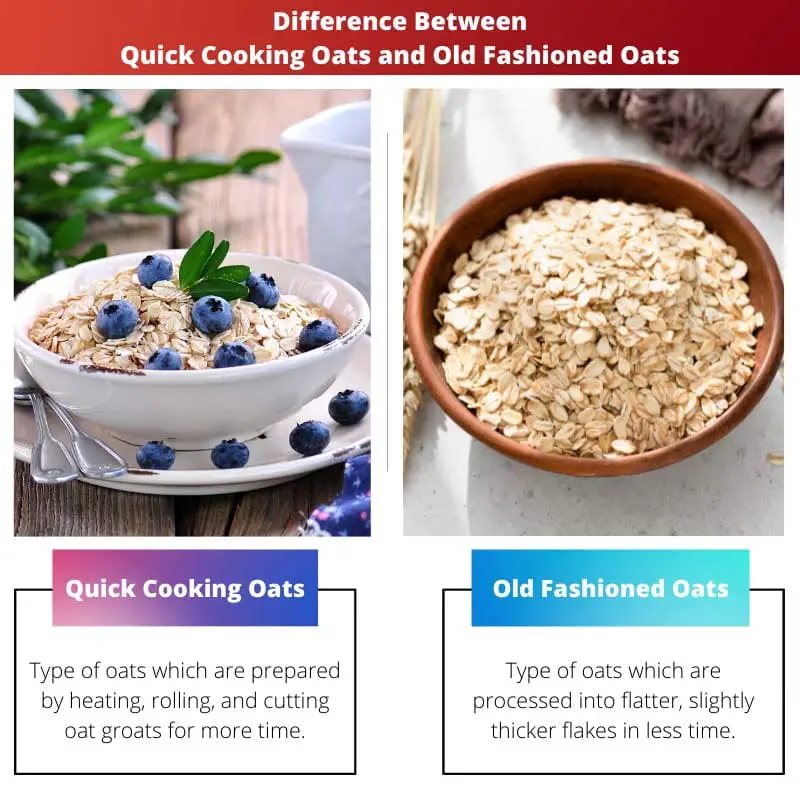Oats are the seed obtained from a plant of the grass family named Avena Sativa. The outer layer is indigestible, known as oat fibres, which are removed in processing.
The Interior part of the seed consisting of oat bran, germ, and endosperm are called Oat Groat. Depending upon processing, cooking time, and flavour, oat groats can be of many types, like steel-cut oats, rolled oats, quick-cooking oats, and instant oats.
Key Takeaways
- Quick-cooking oats have a finer texture as they are cut into smaller pieces.
- Old-fashioned oats take longer to cook due to their larger, thicker flakes.
- Both oats offer similar nutritional benefits, but quick-cooking oats may have a slightly higher glycemic index.
Quick Cooking Oats vs Old Fashioned Oats
Quick oats are instant cooking oats prepared by rolling and cutting oat groats into thin flakes. These are processed oats that give a fine and mushy texture once it is cooked. Old-fashioned oats or rolled oats require more cooking time as it is less processed. It has a rough and thick texture, which becomes mild and chewy after it is cooked.

The process of making both oats starts from oat groats. Quick-cooking oats are processed more into thin pieces. These are rolled into thin, flat pieces and steamed for a longer time to increase oats’ shelf life.
Quick-cooking oats are used in many baking dishes like cookies, muffins, etc.
Old-fashioned oats, commonly called rolled oats, are also rolled, steamed, and cut into flakes which are slightly larger than quick-cooking oats. However, the nutritional value of both types of oats remains the same. These oats are thicker than quick-cooking oats.
Comparison Table
| Parameters of Comparison | Quick Cooking Oats | Old Fashioned Oats |
|---|---|---|
| Definition | Type of oats which are prepared by heating, rolling, and cutting oat groats for more time | Type of oats which are processed into flatter, slightly thicker flakes in less time |
| Cooking Time | These oats take 3-5 minutes to prepare | These oats take 10-15 minutes to cook |
| Thickness of Rolling | These are rolled into thinner flakes. | Their thickness is slightly more than quick-cooking oats |
| Texture | Give a mushy texture to the dish | These oats give a mild, soft, and less mushy texture to the dish |
| Method of Cooking | These oats are cooked partially by steaming | The oats are boiled |
What are Quick Cooking Oats?
When hulls are removed from oats, kernels, or seeds, oat groats are obtained. Hulls are tough and indigestible parts of seeds that protect the seed of the oat plant.
These oat groats are roasted at a low temperature so that their moisture content may be reduced. Oats have a higher fat content, which gets spoiled or rancid. The heating of oats reduces the fat content and increases the shelf life of oats.
Groats are unbroken grains of plants that take more time to cook, so there is a need for further processing. Two things are kept in mind while processing, which are enhancing the flavour and texture of oats and decreasing the cooking time.
After heating, oat groats are rolled into small, thin, flat pieces. Flat surfaces and reduced thickness make these oats easy to cook. Quick-cooking oats have a fine texture and give a mushy appearance to the dish.
Cookies and other dishes made from quick-cooking oats have a smooth, finer appearance due to their small size. These give a uniform texture to the product prepared by baking. It can be further changed into powdery form for other preparations.
Quick-cooking oats are used in many baking dishes like cookies, muffins, etc. These can also be used in making upma, dosa, smoothies, kheer, and khichdi. These are quite fulfilling, so they can be a good healthy option for breakfast in place of fried foods.

What are Old Fashioned Oats?
The old-fashioned oats are also called regular oats or rolled oats. Their processing takes less time, so it can be stated that these are nearer to raw oats. It is the most basic type of oats, which is easily available at a low price.
The cooking time for these oats is 10-15 minutes. These give a mild, chewy texture to the dishes. These oats are not as thin as quacking cooking oats. These give a rougher texture to food items because oats are visible in the finished product.
Old-fashioned oats look like irregular, round, flat discs. These types of oats need more water to become soft, and they retain their shape while cooking.
Oats are fibre-rich cereals and a good source of proteins, vitamins, minerals, and antioxidants. Moreover, they can be a replacement for wheat for people who have an intolerance to gluten, which is the main ingredient in wheat and lacks in oats.
These look similar to Indian poha. They can be eaten in their natural form. Oats do not need rinsing with water and can be consumed as such.
People who are in a hurry for jobs and college need a healthy and fulfilling meal at the start of the day. They can use oats as they take less time to cook, and these are loaded with nutrients and fibres.

Main Differences Between Quick Cooking Oats and Old Fashioned Oats
- Quick-cooking oats are the third level of processing of oat groats, whereas old-fashioned oats are the second level of processing.
- Quick-cooking oats are cooked in a short period, while old-fashioned oats take more time to cook.
- Quick-cooking oats have a soft, powdery or mushy texture. On the other hand, old-fashioned oats have a rustic, coarse texture.
- Quick-cooking oats are small, thin, and flaky in appearance, whereas old-fashioned oats have a slightly thick and disc-shaped structure.
- Quick-cooking oats intermingle with the dish properly and give a pretty finish to the product, whereas old-fashioned oats can be seen in the dishes, thus giving an uneven surface to the food item.

- https://journals.lww.com/nutritiontodayonline/fulltext/2001/03000/oats_nature_s_functional_food.4.aspx
- https://www.taylorfrancis.com/chapters/edit/10.1201/9781420014419-5/occurrence-distribution-content-dietary-intake-phytate-rukma-reddy

The comparison of quick cooking oats and old fashioned oats in this article is both thorough and enlightening.
The article skillfully navigates the distinctions between quick cooking oats and old fashioned oats, contributing to a more comprehensive understanding of these products.
I concur with your assessment. The article delves into the nuanced differences between these two types of oats in a highly informative manner.
This article offers a nuanced exploration of the differences between quick cooking oats and old fashioned oats, providing valuable insights for readers.
I wasn’t aware of the specific differences between quick cooking oats and old fashioned oats. The article has expanded my knowledge on this topic.
I had the same experience after reading this article. It’s intriguing to consider the nuances between these two types of oats.
The thorough comparison of quick cooking oats and old fashioned oats provided valuable insight. I now have a deeper understanding of their distinctions.
The in-depth coverage of quick cooking oats and old fashioned oats in this article serves as a valuable resource for anyone seeking to comprehend the disparities between these two oat varieties.
I found the information about quick cooking oats and old fashioned oats to be illuminating and educational.
The article effectively communicates the key differences between quick cooking oats and old fashioned oats, enhancing our knowledge of this topic.
The comparison table and detailed descriptions of the two types of oats have deepened my understanding of their distinctions. This was an enlightening read.
This article presents a comprehensive analysis of quick cooking oats and old fashioned oats, shedding light on their unique characteristics and uses.
The detailed explanations and comparisons in this article have greatly expanded my understanding of quick cooking oats and old fashioned oats.
Thanks for the informative article detailing the differences between quick cooking oats and old fashioned oats. It’s great to know that their nutritional value is similar despite the variance in texture and cooking time.
I agree, it’s fascinating how the processing of the oats can result in such stark differences in texture and cooking times, while maintaining the same nutritional value.
This article provides a clear and concise breakdown of the details. It was quite enlightening to learn about the preparation of quick cooking oats and old fashioned oats.